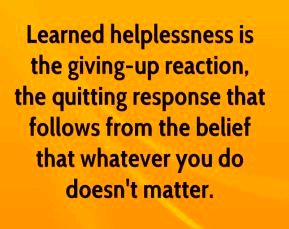 Progress, change, transformation and innovation are all plagued by one organizational culture virus that inhibits growth and success—Learned Helplessness.
Progress, change, transformation and innovation are all plagued by one organizational culture virus that inhibits growth and success—Learned Helplessness.
When leaders and team members alike shut down all new ideas with responses like “It will never work,” “that will never get approved,” or “I wouldn’t even bother…” it’s clear that they’ve given up the hope that anything will change.
Learned Helplessness is a phenomenon that was originally studied in a lab. Psychologists Martin Seligman and Steven Maier used the term to describe the behavior of dogs who, after experiencing inescapable electric shocks behaved as if they were helpless. They stopped trying to avoid the shocks entirely.
Organizations are full of “inescapable shocks” like re-orgs, lay-offs, budget cuts, policy changes, hiring freezes, and mediocre coworkers. Over time, employees who become infected with Learned Helplessness stop seeking out change, solutions, or improvements. They create walls of excuses and get stuck in the status quo. Each excuse breeds more and more self-fulfilling prophecies of failure.
Employees who are paralyzed with Learned Helplessness will also often choose not to give honest, constructive feedback because they don’t believe their honesty will have any effect. They tell others what they want to hear so they can escape the awkward situation and return to mediocrity.
Learned Helplessness is especially common in matrix organizations where leaders have not learned how to drive change without formal power. They make no attempt to influence others, and instead they list other departments as the reason why they’re failing.
Leaders can help bust through a culture of Learned Helplessness by shifting the Locus of Control.
By getting everyone to stop shifting the blame amongst one another and start taking responsibility for their own successes/failures, you shift the locus of control so that it is internal. Everyone becomes the owner of their own destiny.
Here are six ways a leader can combat a culture of Learned Helplessness:
- Ask questions that get to the root of the problem.
- Challenge all assumptions.
- Ask team members to take ownership of a problem and be accountable for creating and implementing a solution.
- Reward behavior that challenges the status quo.
- Share stories of successful change across the organization to break through silos.
- Set an example by avoiding self-defeating negative thoughts. Set the expectation that failure is not an option.
These six steps will take you a long way in breaking through learned helplessness. But also be clear that mistakes are OK. After all, mistakes mean you’re trying something new and taking risks!
